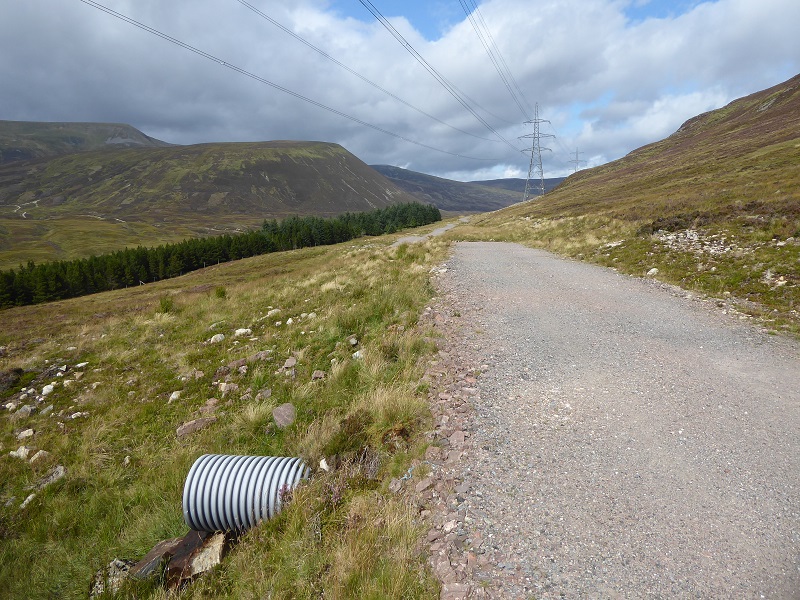
Anyone passing through the Drumochter, even in snow, should be able to see the scars on the hillside between the summit of the pass and north Drumochter lodge but far fewer people are aware of the scars and failed restoration hidden behind the shelter belts on either side of this. Its taken me six months from first blogging about it to find out who agreed that the construction track on the Dalnacardoch Estate (see here) should be left in place, and I am now almost certain that the answer is because Scottish and Southern Electric agreed this with the landowner contrary to the Section 37 Consent issued by the Scottish Government. The track is therefore unlawful and SSE needs to pay for it to be fully restored as originally agreed. This post looks at what is a major failure in our planning enforcement processes to protect the Special Area of Conservation.
The Beauly Denny energy consent required the Drumochter SAC to be fully restored
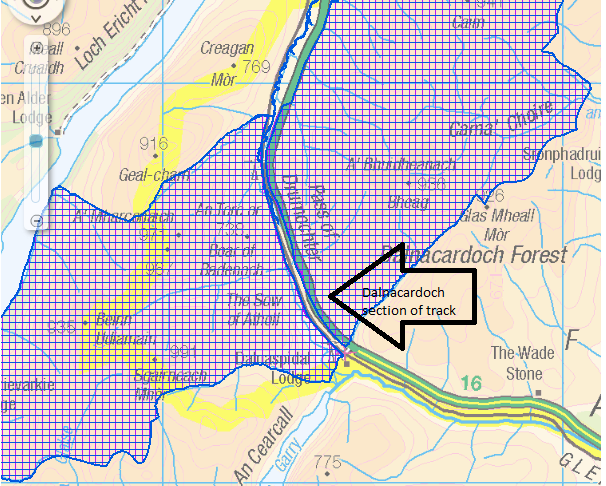
Apart from a very narrow corridor along the A9, most of the Drumochter Hills are a Special Area of Conservation and Special Protection Area for Birds, supposedly our top tier nature designations where habitats are supposed to be protected. It was because of this that the original planning consent granted by the Scottish Government was very clear that any damage caused by the construction of the Beauly Denny had to be fully restored:

And this was spelt out, in Annex 1 of that Final Report, to mean:

The Dalnacardoch Track
Following the approval by the Scottish Government of the “Final Report” multiple further reports were produced setting out the details of how and where the Beauly Denny power line was to be constructed and how it was to be restored. These include documents on track construction and restoration and the Special Area of Conservation (see here for example) which are not readily available and are confusing to follow but all, as far as I have been able to ascertain, appear to reinforce the original decision, that the SAC should be fully restored.
What happened for a section of the line running through the Dalnacardoch Estate, however, was that in order to reduce impacts, it was proposed that the former Wade’s Rd would be used as the construction track:
“Existing tracks would be used wherever possible. With respect to the transmission line corridor through the Drumochter Hills SAC and SSSI, approximately 2,200m section of existing track (along General Wade’s Military Road) is to be used for access, from tower FT156 to tower FT163, see Figure 1d. General Wade’s Military Road may be subject to some upgrade, which would be limited to improving the track surface and would not result in any additional impacts to habitats;”
Just how anyone thought that what should be an ancient monument, much of which had been reclaimed by bog and moor, should be used as a construction track and would be able to support heavy vehicles is not clear but that is what SSE proposed to do:
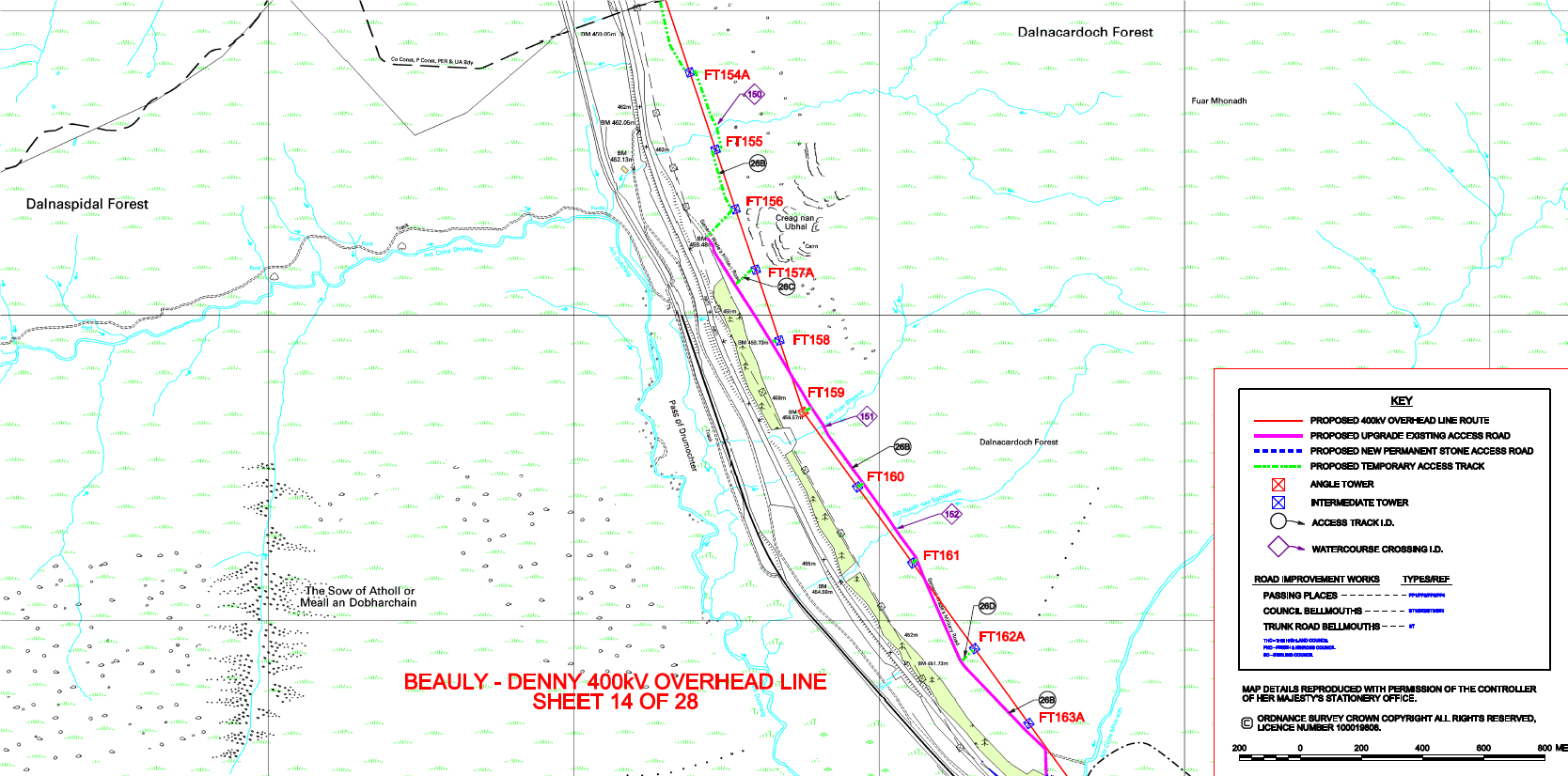
What then appears to have happened is that SSE or the contractors found that “some upgrade” of Wade’s Road was not sufficient and this had two consequences. Firstly, in some places a totally new construction track was created:
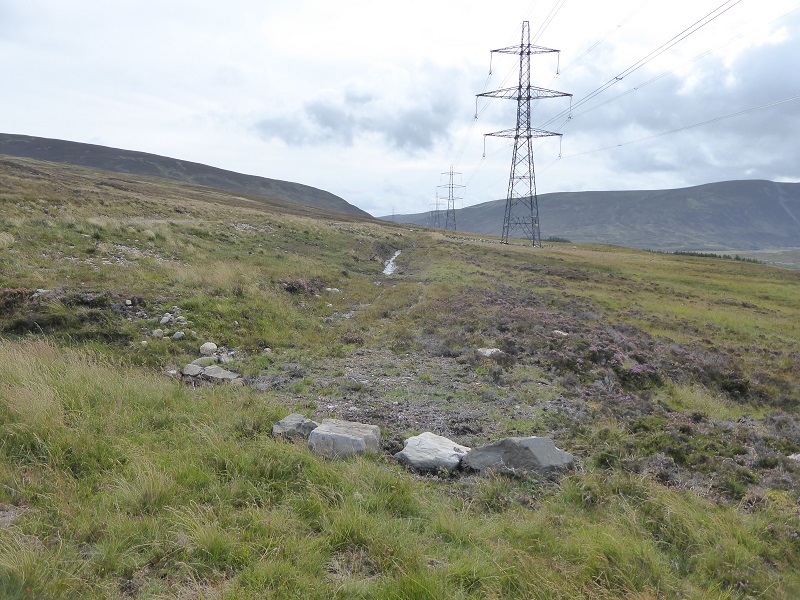
According to the planning consent all new tracks for construction purposes in the SAC should have been fully restored in order to avoid loss of habitat. This has failed to happen at Dalnacardoch.
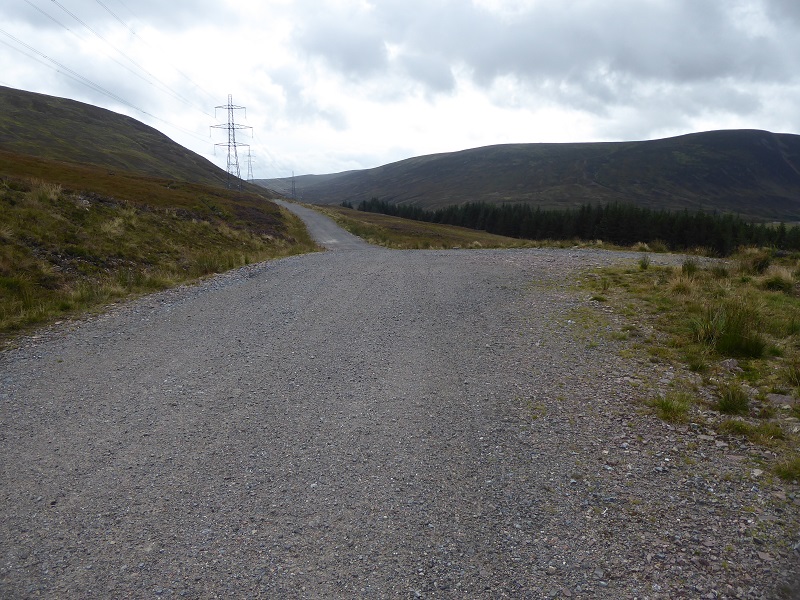
Secondly, in other places a totally new track appears to have been constructed over and on the line of the Wade’s Rd and as a result sections of track like that above may represent the “upgrade”. These sections are clearly far more than an upgrade and have resulted in the destruction of a swathe of protected habitat. The fact that they have also been constructed to a poor standard suggests they may originally have been to be temporary but have ended up just being left in place. This is a contravention of Scottish and EU Law on the protection of the natura site habitats.
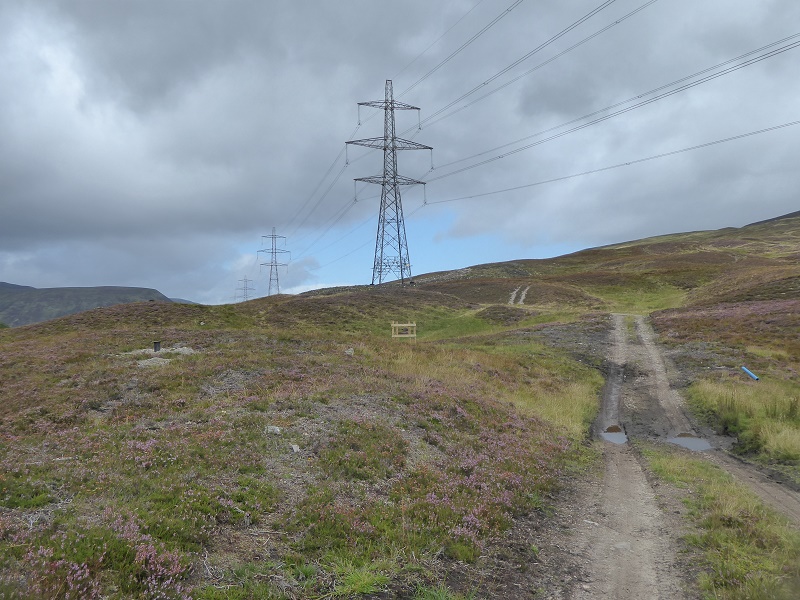
Further evidence that planning requirements have been breached comes from the above photo which shows how the upgraded construction track should have looked if properly restored. I don’t know if this short section which leads up to the new Dalnacardoch track was ever used for construction purposes but it looks and has a totally different impact to the track beyond.
The cover-up by SSE
While SSE has been very helpful providing me with maps and information missing from the Scottish Government Energy Consents website, they have not explained to me who actually authorised the retention of the Dalnacaroch section of track. The reason for this I now believe is it has not been authorised but instead there appears to have been some private arrangement between SSE and the landowner which in effect has got round the planning consent. This has saved SSE a lot of money in restoration costs (and also at the cost of a lot of jobs) and given the Dalnacardoch a spanky new track for grouse moor management purposes (my previous post showed some of the traps that can be seen along the track).
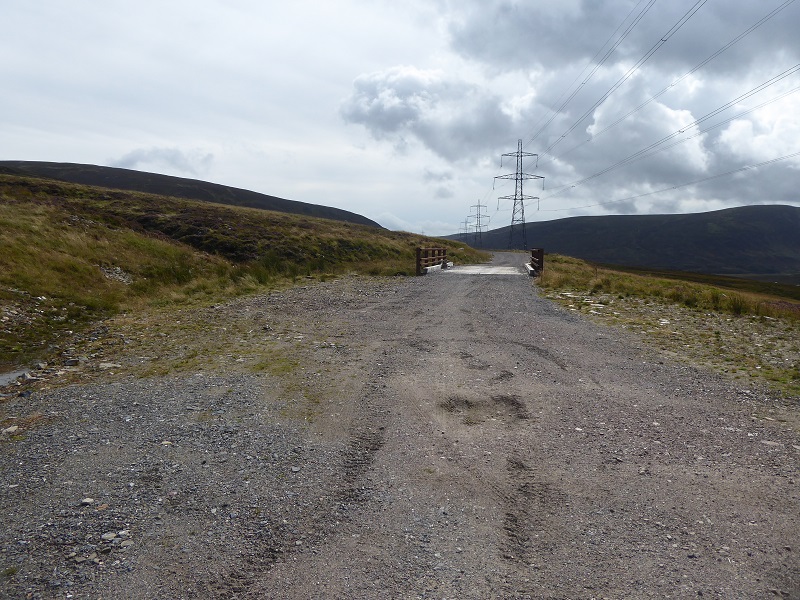
Part of the evidence that there has been a deliberated cover up comes from the annual restoration reports on the Beauly Denny which the CNPA have provided to me (by return!) under FOI. In neither the 2016 or 2017 restoration report (see here for 2017) is there any mention of the impact of the Dalnacardoch track – track 26b in the report – on the SAC, let alone that sections of it were new, contrary to the planning consent, or consideration of whether the “upgrade” met planning requirements. That, in my view, is a massive failure and raises wider questions about where else along the Beauly Denny has SSE failed to report properly on what is going on.
What needs to happen
I have been in touch with both the CNPA and SNH about the Dalnacardoch track, partly to establish what is going on. Both have confirmed that they have not consented to the new track as described above and both agree the track raises significant issues in relation to the Special Area of Conservation. As a consequence I think we can take it that both CNPA and SNH now believe the Dalnacardoch track appears to breach the Section 37 planning consent.
In the old days SNH would have monitored works in SACs very carefully and its a sad reflection of the cuts that they no longer have the resources to protect natural environments properly and rely on members of the public to report concerns to them. I delighted to be able to report, however, that the CNPA and SNH now appear to be working together on this and that the CNPA has raised the issues with the Energy Consents Unit at the Scottish Government. It is therefore now up to the Scottish Government to take effective enforcement action and ensure the habitat is restored as was intended on the Dalnacardoch section of the Beauly Denny.
Should the Scottish Government fail to do so I believe they will in breach of the Habitats Regulations – and they could as a result be referred to the EU for failing to carry out their duties under international law up to the moment we leave the EU.
As well as taking immediate action to remove the Dalnacardoch track, the Scottish Government however should be taking a much wider look at the effectiveness of the Beauly Denny restoration. In my view it should no longer rely on SSE’s Restoration Monitoring reports to provide a picture of what is happening because these reports are clearly incomplete. There is further excellent evidence for this just a little north of the Dalnacardoch track on the north Drumochter estate where the construction track has been removed but not restored properly (see here):
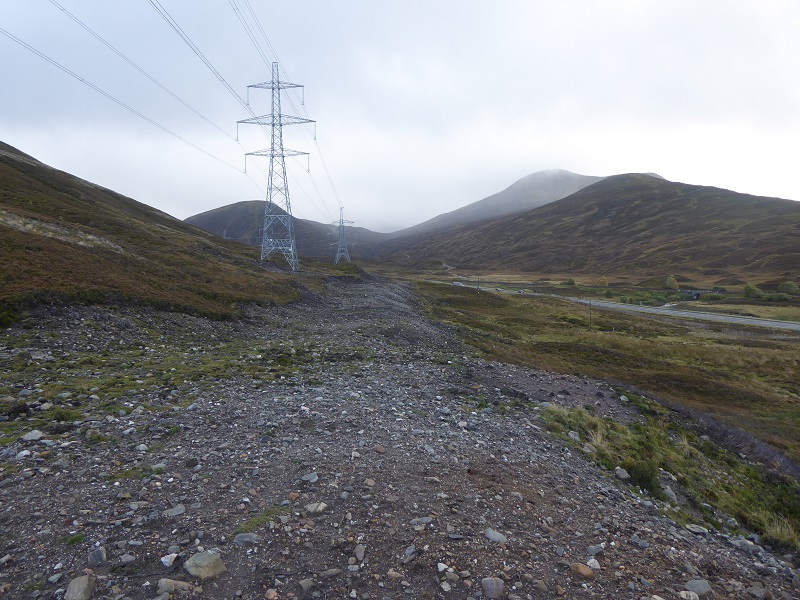
The SSE Restoration monitoring reports are focussed on recovery of vegetation and are based on the premise that this should regenerate naturally (to their credit CNPA staff have raised concerns about this). The bigger issue though is SSE’s current approach is contrary to the original planning consent which required landforms to be properly restored – there has been NO landscape restoration of the scar cut into the hillside by the temporary construction track (photo above) – and for turves and other vegetation to be properly stored before being replaced. Having changed the composition of the soils by mixing peat with stone, any natural regeneration that takes place here – and its being impeded by continued vehicle use of the “former” track – is likely to lead to a change in species composition. The Scottish Government therefore now need to require SSE to commission an independent restoration plan, involving SNH and the CNPA, which first set outs how the landscape will be restored so the line of the construction track disappears and then how vegetation can be restored (drawing on the evidence of the successful restoration of Glen Bruar after the initial disaster there (see here). They then need to ensure this happens.
At the end of day I believe this is all about money. SSE could have – and still could – restore the Drumochter as originally envisaged but despite trying to project an image of being a socially and environmentally responsible company the drive to save money and increase profits whereever they can still determines what happens on the ground. The public should not allow them to get away with this.
This is yet another example of public authorities doing the minimum on enforcement of planning consents and hoping that no-one notices. At least CNPA and SNH now appear to be trying to do something about the issues you have raised. It will be interesting to see how long the Scottish Government ‘drags its feet’ and hopes the issues will go away.
What the Scottish Government should do is commission a full and objective inspection of all required restoration work over the whole of the Beauly-Denny line, this being paid for by SSE, but I suspect they will do the minimum to get by and hush up the issues, as they don’t want anything to detract from their major ‘environmental success’ with the linking up of the northern wind turbines.
On a different matter in this area, when next driving on the A9, its worthwhile looking at the trail of litter which lines both sides of this major trunk road – its a disgrace – but yet again our Scottish Government and its local authorities will do little or nothing about prevention of littering in our countryside, whether on SAC, SSSI or not.
Anyone watching the construction of the access tracks would have noticed that almost no effort was made to separate out or protect the turves and very thin soils in this area. This turf removal is entirely possible to do, even in very shallow stoney soils, it just takes time and the Contractor/Developer employing good digger drivers. Well done on following this through.